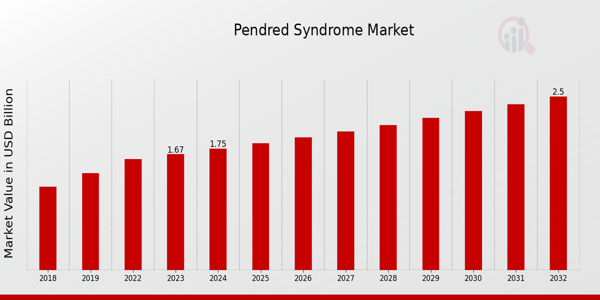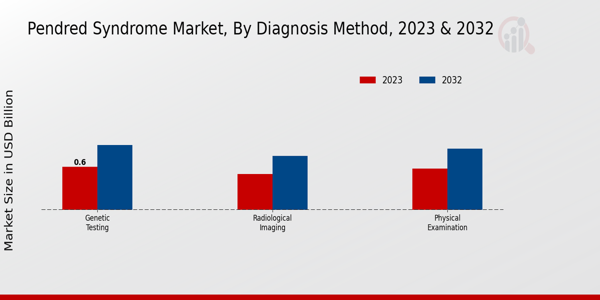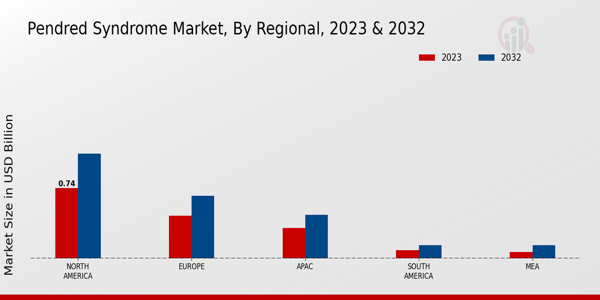Global Pendred Syndrome Market Overview
As per MRFR analysis, the Pendred Syndrome Market Size was estimated at 1.83 (USD Billion) in 2024. The Pendred Syndrome Market Industry is expected to grow from 1.91 (USD Billion) in 2025 to 2.86 (USD Billion) till 2034, at a CAGR (growth rate) is expected to be around 4.56% during the forecast period (2025 - 2034).
Key Pendred Syndrome Market Trends Highlighted
The Pendred Syndrome Market is currently witnessing several key market drivers that are significantly influencing its growth. Increasing awareness of genetic disorders and advancements in genetic testing technologies are fostering early diagnosis of Pendred syndrome. This awareness has led to a rise in demand for specialized healthcare services and customized treatment plans for affected individuals. Moreover, a growing emphasis on healthcare infrastructure improvements and the integration of genetic counseling into standard medical practices are further propelling market expansion. Additionally, the increasing prevalence of hearing disorders globally is expected to bolster the demand for effective treatment options for Pendred Syndrome.Opportunities within the market are ripe for exploration, especially concerning innovative therapeutic solutions. The development of targeted therapies and the potential for gene therapies present a promising avenue for new treatment options. Collaborations between genetic research institutions and pharmaceutical companies can enhance the development of effective interventions. Furthermore, the rise of telemedicine and digital health solutions offers a unique opportunity to improve patient engagement and follow-up care, making treatment more accessible to those in remote areas. Trends in recent times indicate a shift towards a more personalized approach in treating genetic disorders, including Pendred syndrome.
There is a notable increase in research focused on the genetic roots and pathophysiology of the syndrome, leading to a deeper understanding that may enhance treatment effectiveness. Additionally, the growing importance of multidisciplinary approaches in patient management highlights the collaboration between otolaryngologists, geneticists, and audiologists. This trend aims to provide comprehensive care that addresses not only the symptoms but also the underlying causes of Pendred syndrome. Such integrated care models will likely become a standard practice in the coming years, ensuring that patients receive holistic treatment tailored to their specific needs.

Source: Primary Research, Secondary Research, MRFR Database and Analyst Review
Pendred Syndrome Market Drivers
Increasing Awareness and Diagnosis of Pendred Syndrome
One of the most significant drivers of growth in the Pendred Syndrome Market Industry is the increase in awareness and diagnosis of Pendred syndrome among healthcare professionals and the general public. Pendred syndrome is a genetic condition that often leads to hearing loss and thyroid issues, which can significantly affect an individual's quality of life. As medical communities become more knowledgeable about the condition, there has been a corresponding uptick in the accurate diagnosis of Pendred syndrome.Advancements often aid this increased diagnosis in genetic testing and biomarkers that allow for earlier identification of the condition. Clinics and hospitals are also increasingly adopting initiatives to educate both patients and practitioners about the signs, symptoms, and genetic underpinnings of this disorder. Such heightened awareness leads to timely interventions and management strategies tailored to individual needs. As more cases are recognized, there is a growing demand for specialized healthcare services, therapies, and products that cater specifically to the needs of Pendred syndrome patients.
Advancements in Genetic Research
The advancements in genetic research represent a significant driver for the Pendred Syndrome Market Industry. As researchers delve deeper into the genetic factors contributing to Pendred syndrome, new insights emerge that facilitate better understanding and management of the condition. Innovations in gene therapy and personalized medicine are paving the way for more targeted treatment options that can improve patient outcomes. These scientific breakthroughs not only enhance clinical practices but also generate interest from pharmaceutical companies looking to develop specialized medications or therapies that can effectively treat or mitigate the symptoms related to Pendred syndrome.
Growing Investment in Rare Disease Treatments
Another prominent driver of the Pendred Syndrome Market Industry is the growing investment in treatments for rare diseases. Government bodies, non-profit organizations, and private sector entities are increasingly committing resources to understand better and develop interventions for conditions like Pendred syndrome. This influx of funding opens new avenues for research and development, allowing for advancements in treatment protocols and innovative care options.
Pendred Syndrome Market Segment Insights:
Pendred Syndrome Market Diagnosis Method Insights
The Pendred Syndrome Market exhibits diverse methodologies in its Diagnosis Method segment, showcasing significant advancements and growing awareness in diagnosing this condition. In 2023, the overall market value reached 1.67 USD Billion, and as the market progresses towards 2032, it is anticipated to attain a value of 2.5 USD Billion, reflecting the increasing emphasis on efficient diagnostic methods. Within this segment, Genetic Testing emerges as a dominant player, valued at 0.6 USD Billion in 2023 and expected to grow to 0.9 USD Billion by 2032.This method is vital because it allows for definitive diagnosis of Pendred Syndrome through identification of the specific genetic mutations that cause the disorder, making it paramount in guiding treatment strategies. Radiological Imaging also holds a noteworthy share, valued at 0.5 USD Billion in 2023 and projected to reach 0.75 USD Billion by 2032, supporting clinical evaluations through advanced imaging techniques that help visualize associated abnormalities, thus aiding in clinical assessment and planning of care.
Physical Examination, valued at 0.57 USD Billion in 2023 with expectations of climbing to 0.85 USD Billion in 2032, serves as a crucial, non-invasive means of detecting clinical manifestations of the syndrome; however, it remains the least dominant method compared to Genetic Testing and Radiological Imaging.Each of these methods contributes significantly to the overall Pendred Syndrome Market revenue by enhancing diagnostic accuracy and patient outcomes, driven by ongoing innovations and heightened awareness among healthcare professionals. The market growth is supported by an increasing incidence rate of Pendred Syndrome and advancements in genetic research and technology, presenting ample opportunities for further development and integration of these diagnostic methods into clinical practices. Challenges such as accessibility to genetic testing and the need for trained personnel in Radiological Imaging continue to shape the market dynamics.

Source: Primary Research, Secondary Research, MRFR Database and Analyst Review
Pendred Syndrome Market Treatment Type Insights
The Pendred Syndrome Market revenue is significantly driven by the Treatment Type segment, encompassing various therapeutic approaches such as Surgical Intervention, Hearing Aids, Cochlear Implants, and Medication. As of 2023, the overall market value reached 1.67 billion USD, reflecting a growing need for effective treatment methods for this genetic condition.
Surgical Intervention remains vital due to its role in addressing complications associated with Pendred Syndrome, enabling improved quality of life for patients. Hearing Aids and Cochlear Implants are also crucial, as they significantly enhance auditory capabilities for individuals facing hearing loss, which is common in Pendred Syndrome cases.These technologies are increasingly adopted, especially as awareness around hearing disorders expands. Medication plays a supportive role in managing symptoms and associated health issues, thus contributing to the comprehensive care of those affected by this syndrome.
Overall, the Pendred Syndrome Market segmentation illustrates a diverse landscape of treatment modalities, each playing a pivotal role in patient management and highlighting the industry's commitment to addressing the challenges faced by this patient population.
Pendred Syndrome Market Patient Age Group Insights
The Pendred Syndrome Market encompasses a diverse range of age groups, particularly focusing on Infants, Children, Adults, and the Elderly. In 2023, the market was poised to facilitate advancements in medical treatments specifically tailored for these distinct age categories. The prevalence of Pendred Syndrome is noted to be significant among infants, which emphasizes the importance of early diagnosis and intervention. As children grow, their specific healthcare needs evolve, making pediatric considerations crucial. Adults may face different challenges regarding the management of Pendred Syndrome, solidifying their importance within the market.The elderly demographic requires tailored healthcare strategies as age-related complications may arise. The increasing awareness of Pendred Syndrome across all age groups contributes to the growth of the Pendred Syndrome Market revenue. As the market progresses, the segmentation around Patient Age Groups is expected to gain momentum due to the unique healthcare demands characteristic of each group. This demographic insight underlines the market's potential to customize treatment solutions and drive innovation in the industry, aligning with ongoing trends focused on age-specific healthcare.
Pendred Syndrome Market Healthcare Setting Insights
The Pendred Syndrome Market in the Healthcare Setting was valued at 1.67 billion USD in 2023, reflecting its crucial role in addressing the medical needs associated with this genetic condition. This market is segmented into various important areas, such as hospitals, specialty clinics, and home care services, each contributing significantly to patient management and treatment solutions. Hospitals generally serve as major healthcare providers, offering comprehensive care for Pendred Syndrome, which includes advanced diagnostic and therapeutic options.Specialty clinics often focus on tailored care plans, emphasizing the necessity of specialized medical attention for such specific conditions, thus holding a significant portion of the market. Home care services have also gained traction as they offer flexibility and personalized support, particularly for patients needing long-term care in a comfortable setting. As patient awareness and the prevalence of Pendred Syndrome increase, these healthcare settings are expected to play an integral role in improving treatment accessibility and outcomes.The Pendred Syndrome Market data highlights the growth drivers, including advancements in genetic research and increasing healthcare investments, while also being challenged by factors such as healthcare costs and resource availability. The dynamics of this market reflect significant opportunities for growth and innovation, reinforcing the importance of effective healthcare solutions tailored for Pendred Syndrome.
Pendred Syndrome Market Regional Insights
The Pendred Syndrome Market exhibits a diverse regional landscape, with North America leading as a significant contributor, valued at 0.74 USD Billion in 2023 and projected to rise to 1.1 USD Billion by 2032, showing its majority holding in the market. Europe follows, reflecting a valuation of 0.45 USD Billion in 2023, increasing to 0.66 USD Billion, highlighting its notable presence. The Asia-Pacific region, valued at 0.32 USD Billion in 2023 and expected to reach 0.46 USD Billion, demonstrates promising growth potential. South America, while smaller in scale, valued at 0.09 USD Billion in 2023, is projected to grow to 0.14 USD Billion.The Middle East and Africa hold a minor share as well, starting at 0.07 USD Billion in 2023 and expected to double to 0.14 USD Billion. This regional segmentation underlines the variations in market demand, influenced by factors such as healthcare infrastructure, awareness levels, and economic conditions, contributing to the broader Pendred Syndrome Market revenue and its growth dynamics.

Source: Primary Research, Secondary Research, MRFR Database and Analyst Review
Pendred Syndrome Market Key Players and Competitive Insights:
The Pendred Syndrome Market has demonstrated notable growth amid rising awareness regarding genetic disorders affecting hearing. As a hereditary condition, Pendred Syndrome presents a complex interplay of medical, social, and economic factors that influence its management and treatment. The competitive landscape in this market is characterized by a blend of established pharmaceutical companies and emerging biotechnology firms striving to develop therapies and support services tailored for patients.
With advancements in genetic research and personalized medicine, companies are increasingly focusing on specialized treatments that cater to the unique needs of individuals diagnosed with Pendred Syndrome. The nature of this market challenges organizations to innovate continuously while navigating regulatory frameworks, reimbursement scenarios, and patient advocacy, all of which impact therapeutic uptake and market penetration.Pfizer has established a significant presence in the Pendred Syndrome Market through its extensive portfolio and commitment to research and development. The company boasts a strong focus on rare genetic disorders and has invested in understanding the genetic basis of various conditions, including Pendred Syndrome. This strength is complemented by Pfizer's robust distribution network and strategic partnerships that enable its therapies to reach a wider audience effectively. Focused on patient-centered approaches, Pfizer employs methodologies that facilitate better diagnosis and treatment outcomes, enhancing the quality of care for individuals affected by this syndrome. Moreover, the firm's reputation for high-quality research bolsters its credibility within the market, further solidifying its competitive position.Amgen has also made strides in the Pendred Syndrome Market, emphasizing innovative research and a comprehensive approach to addressing genetic health challenges. Renowned for its commitment to applying advanced biotechnology in developing therapeutic solutions, Amgen leverages cutting-edge techniques to explore new avenues for treatment. The company's strengths lie in its strong pipeline, extensive clinical research capabilities, and a legacy of successful product launches in niche markets. Their focus on personalized medicine aligns well with the trends surrounding Pendred Syndrome, allowing them to trial new drugs tailored to genetic variations within the patient population. Amgen's strong collaborations with healthcare professionals and institutions enhance its ability to address the specific needs of patients with Pendred Syndrome, driving improved patient outcomes and reinforcing its competitive edge in the evolving landscape of genetic disorders.
Key Companies in the Pendred Syndrome Market Include:
- Pfizer
- Amgen
- Merck
- Takeda
- Eli Lilly
- Celgene
- AbbVie
- GSK
- Roche
- AstraZeneca
- BioMarin Pharmaceutical
- Bayer
- Novartis
- Sanofi
- Mallinckrodt
Pendred Syndrome Market Industry Developments
The Pendred Syndrome Market has witnessed significant developments recently, with leading pharmaceutical companies like Pfizer, Amgen, Merck, and Takeda focusing on innovative treatments and therapies aimed at addressing this rare genetic condition. Eli Lilly and Roche have made advancements in genetic research, aiming to understand better the underlying mechanisms of Pendred Syndrome, which is critical for developing targeted therapies. Furthermore, recent growth in market valuation for companies such as BioMarin Pharmaceutical and Novartis reflects the increasing investment in rare diseases, driven by heightened awareness and advancements in genetic testing.
Notably, there have been acquisitions and mergers among some of the key players in the market, enhancing their capabilities in drug development and expanding their portfolios for rare conditions. Companies like AbbVie and GSK have also been active in forming strategic collaborations to accelerate research in hearing loss associated with Pendred Syndrome, ultimately aiming to bring more effective treatment options to patients. The ongoing collaboration among these companies signifies a strong commitment to addressing unmet medical needs in this area, influencing market dynamics positively as the overall landscape evolves.
Pendred Syndrome Market Segmentation Insights
- Pendred Syndrome Market Diagnosis Method Outlook
- Genetic Testing
- Radiological Imaging
- Physical Examination
- Pendred Syndrome Market Treatment Type Outlook
- Surgical Intervention
- Hearing Aids
- Cochlear Implants
- Medication
- Pendred Syndrome Market Patient Age Group Outlook
- Infants
- Children
- Adults
- Elderly
- Pendred Syndrome Market Healthcare Setting Outlook
- Hospitals
- Specialty Clinics
- Home Care
| Report Attribute/Metric |
Details |
|
Market Size 2024
|
1.83 (USD Billion)
|
|
Market Size 2025
|
1.91 (USD Billion)
|
|
Market Size 2034
|
2.86 (USD Billion)
|
|
Compound Annual Growth Rate (CAGR)
|
4.56 % (2025 - 2034)
|
|
Report Coverage
|
Revenue Forecast, Competitive Landscape, Growth Factors, and Trends
|
|
Base Year
|
2024
|
|
Market Forecast Period
|
2025 - 2034
|
|
Historical Data
|
2020 - 2024
|
| Market Forecast Units |
USD Billion |
| Key Companies Profiled |
Pfizer, Amgen, Merck, Takeda, Eli Lilly, Celgene, AbbVie, GSK, Roche, AstraZeneca, BioMarin Pharmaceutical, Bayer, Novartis, Sanofi, Mallinckrodt |
| Segments Covered |
Diagnosis Method, Treatment Type, Patient Age Group, Healthcare Setting, Regional |
| Key Market Opportunities |
Rising awareness of genetic disorders, Advancements in diagnostic technologies, Growing support from healthcare organizations, Innovative treatment options development, Increased funding for rare diseases research |
| Key Market Dynamics |
Increasing prevalence of Pendred Syndrome, Growing awareness of genetic disorders, Advancements in diagnostic techniques, Rising demand for targeted therapies |
| Countries Covered |
North America, Europe, APAC, South America, MEA |
Frequently Asked Questions (FAQ) :
The Pendred Syndrome Market is expected to be valued at 2.5 USD Billion in 2034.
The expected CAGR for the Pendred Syndrome Market from 2025 to 2034 is 4.56%.
The market value of Radiological Imaging in the Pendred Syndrome Market is projected to reach 0.75 USD Billion by 2034.
Some of the key players in the Pendred Syndrome Market include Pfizer, Amgen, Merck, Takeda, and Eli Lilly.
What will the market value of South America be in the Pendred Syndrome Market by 2034?
The market value of Physical Examination in the Pendred Syndrome Market is projected to be 0.85 USD Billion in 2034.
The projected market value for Europe in the Pendred Syndrome Market is estimated to be 0.66 USD Billion by 2034.
The expected market value of the APAC region for the Pendred Syndrome Market is estimated to be 0.46 USD Billion in 2034.

















